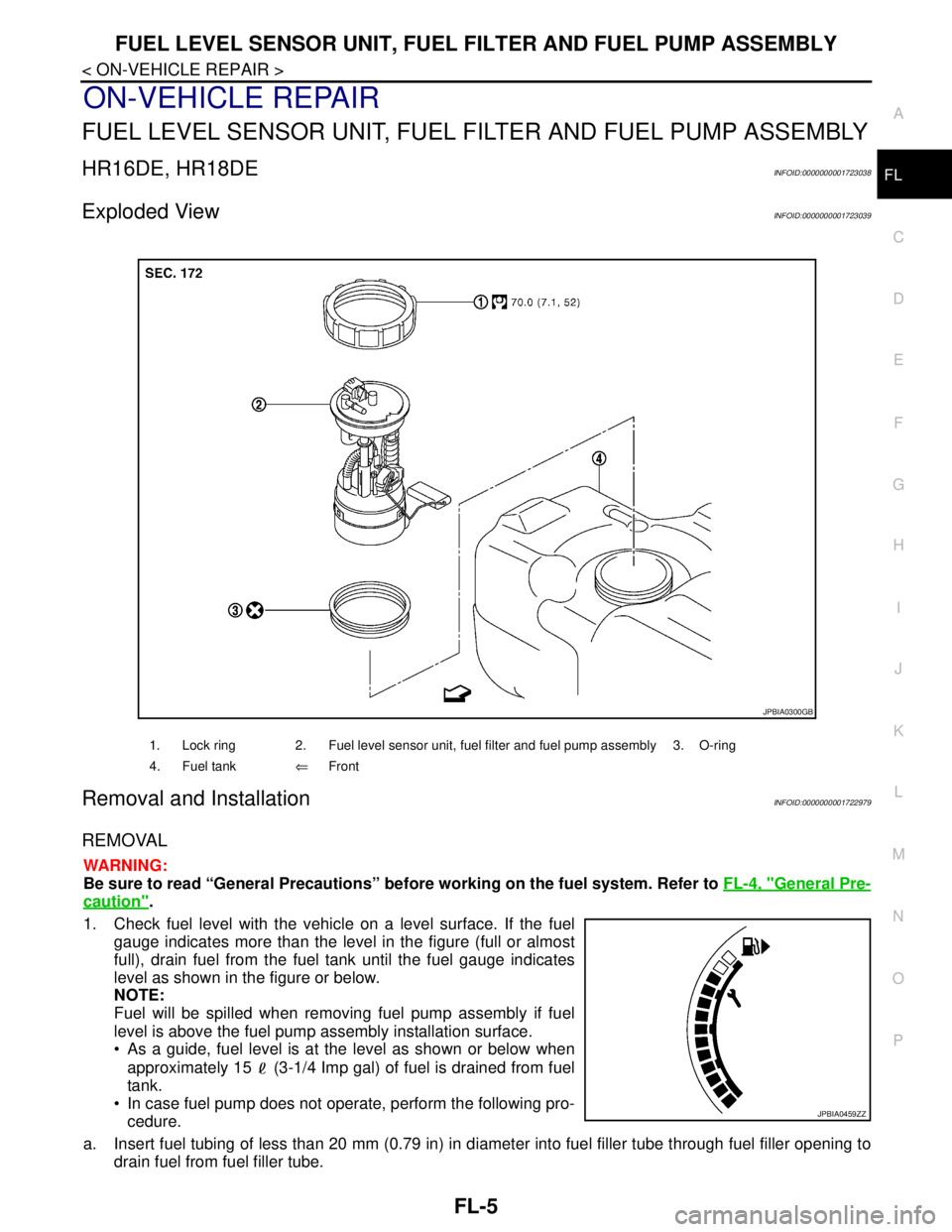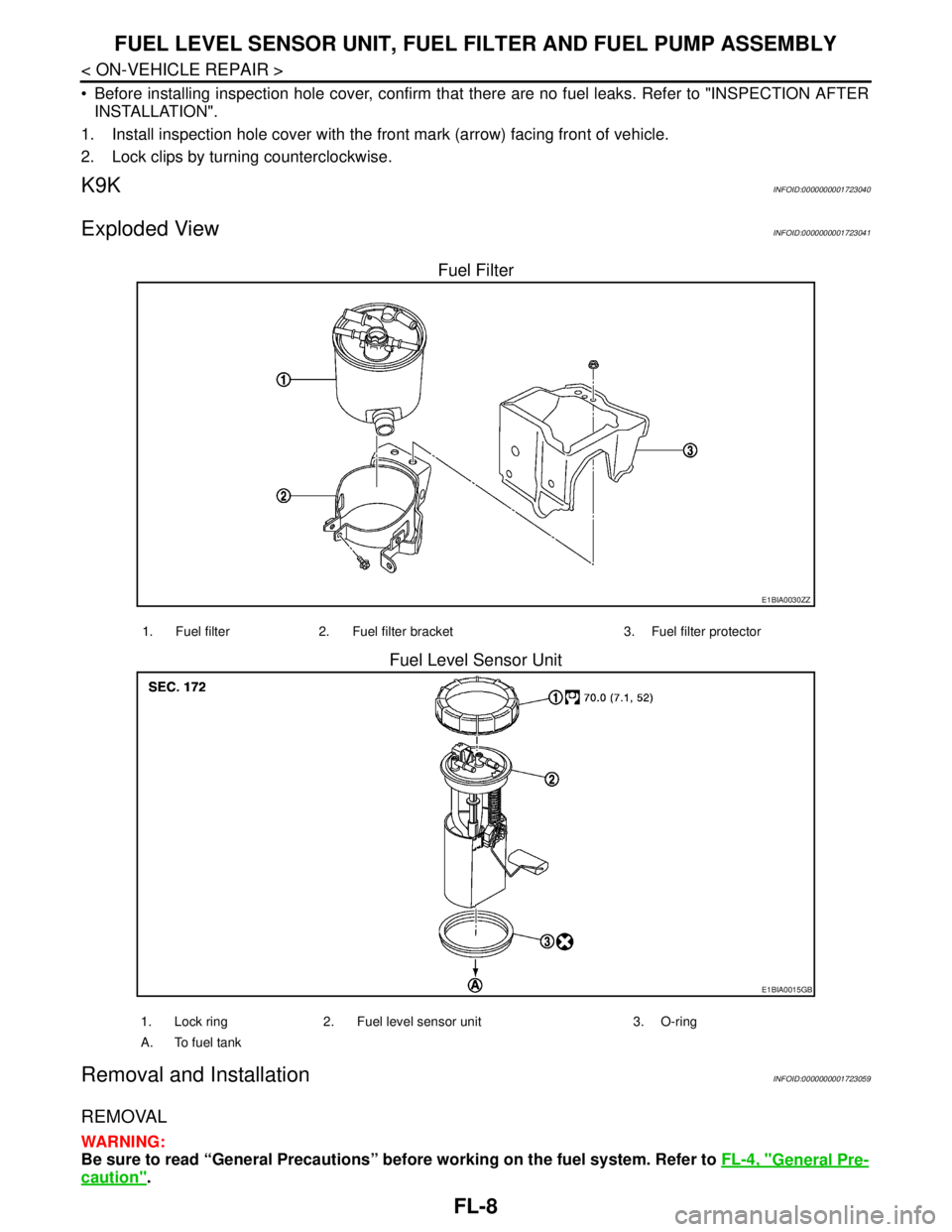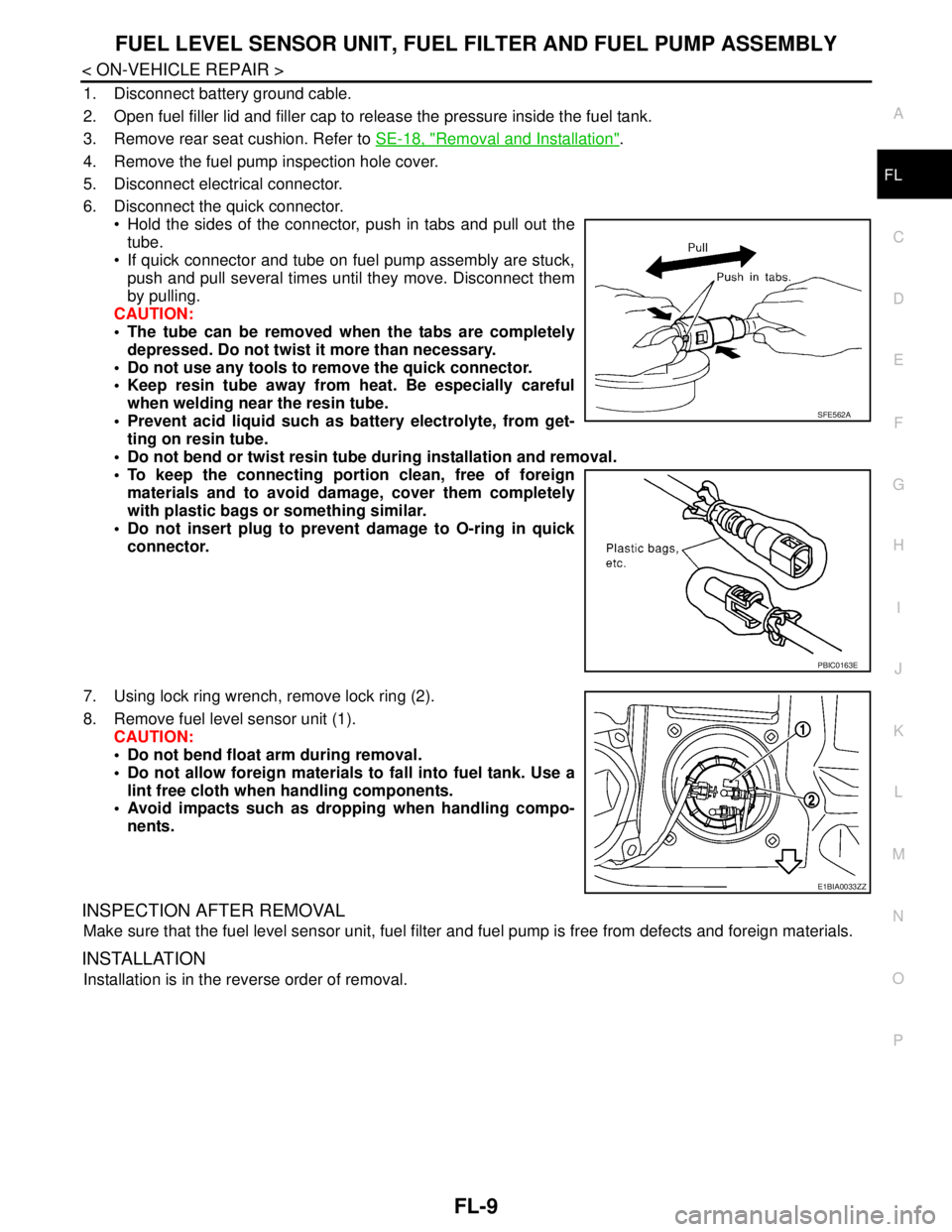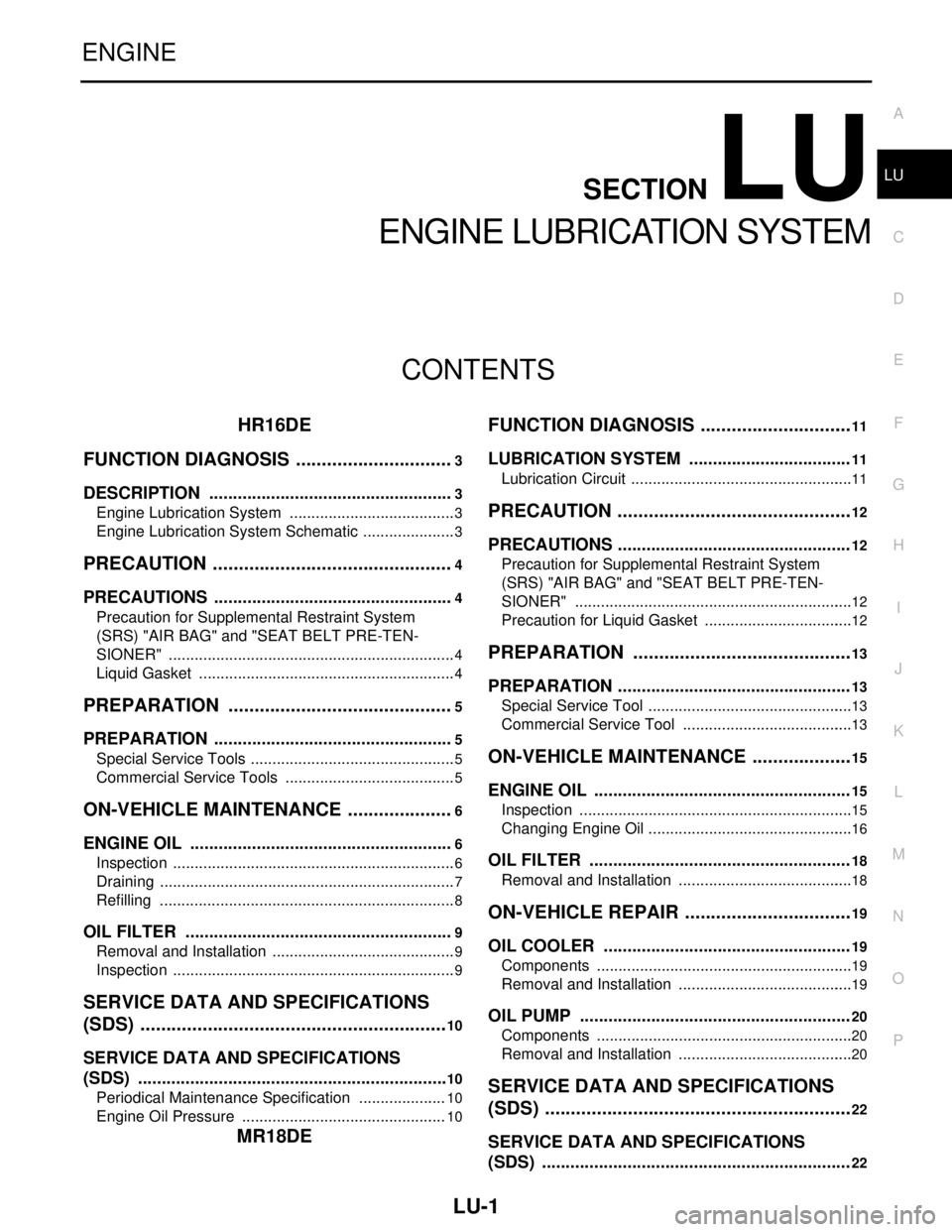2007 NISSAN TIIDA Air filter
[x] Cancel search: Air filterPage 3165 of 5883

FUEL LEVEL SENSOR UNIT, FUEL FILTER AND FUEL PUMP ASSEMBLY
FL-5
< ON-VEHICLE REPAIR >
C
D
E
F
G
H
I
J
K
L
MA
FL
N
P O
ON-VEHICLE REPAIR
FUEL LEVEL SENSOR UNIT, FUEL FILTER AND FUEL PUMP ASSEMBLY
HR16DE, HR18DEINFOID:0000000001723038
Exploded ViewINFOID:0000000001723039
Removal and InstallationINFOID:0000000001722979
REMOVAL
WARNING:
Be sure to read “General Precautions” before working on the fuel system. Refer to FL-4, "
General Pre-
caution".
1. Check fuel level with the vehicle on a level surface. If the fuel
gauge indicates more than the level in the figure (full or almost
full), drain fuel from the fuel tank until the fuel gauge indicates
level as shown in the figure or below.
NOTE:
Fuel will be spilled when removing fuel pump assembly if fuel
level is above the fuel pump assembly installation surface.
As a guide, fuel level is at the level as shown or below when
approximately 15 (3-1/4 Imp gal) of fuel is drained from fuel
tank.
In case fuel pump does not operate, perform the following pro-
cedure.
a. Insert fuel tubing of less than 20 mm (0.79 in) in diameter into fuel filler tube through fuel filler opening to
drain fuel from fuel filler tube.
1. Lock ring 2. Fuel level sensor unit, fuel filter and fuel pump assembly 3. O-ring
4. Fuel tank⇐Front
JPBIA0300GB
JPBIA0459ZZ
Page 3166 of 5883

FL-6
< ON-VEHICLE REPAIR >
FUEL LEVEL SENSOR UNIT, FUEL FILTER AND FUEL PUMP ASSEMBLY
b. Disconnect fuel filler hose from fuel filler tube. Refer to FL-10, "HR16DE, HR18DE".
c. Insert fuel tubing into fuel tank through fuel filler hose to drain fuel from fuel tank.
2. Release the fuel pressure from the fuel lines. Refer to EC-377, "
Inspection" (HR16DE with EURO-OBD),
EC-681, "
Inspection" (HR16DE without EURO-OBD), EC-1035, "Inspection" (MR18DE).
3. Open fuel filler lid.
4. Open fuel door and unscrew the fuel filler cap to release the pressure inside the fuel tank.
5. Remove rear seat bottom. Refer to SE-18, "
Removal and Installation".
6. Turn the four retainers 90° in a clockwise direction and remove the fuel pump inspection hole cover.
7. Disconnect electrical connector (A) and fuel feed hose quick
connector (B).
⇐ : Vehicle front
Disconnect the quick connector using the following procedure.
- Hold the sides of the connector, push in tabs and pull out the
tube.
- If quick connector and tube on fuel pump assembly are stuck,
push and pull several times until they move. Disconnect them
by pulling.
CAUTION:
The tube can be removed when the tabs are completely
depressed. Do not twist it more than necessary.
Do not use any tools to remove the quick connector.
Keep resin tube away from heat. Be especially careful
when welding near the resin tube.
Prevent acid liquid such as battery electrolyte, from get-
ting on resin tube.
Do not bend or twist resin tube during installation and removal.
To keep the connecting portion clean, free of foreign
materials and to avoid damage, cover them completely
with plastic bags or something similar.
Do not insert plug to prevent damage to O-ring in quick
connector.
JPBIA0457ZZ
SFE562A
PBIC0163E
Page 3167 of 5883

FUEL LEVEL SENSOR UNIT, FUEL FILTER AND FUEL PUMP ASSEMBLY
FL-7
< ON-VEHICLE REPAIR >
C
D
E
F
G
H
I
J
K
L
MA
FL
N
P O
8. Remove the lock ring using tool as shown.
9. Remove fuel level sensor unit, fuel filter and fuel pump assembly (1).
CAUTION:
Do not bend float arm during removal.
Do not allow foreign materials to fall into fuel tank. Use a lint free cloth when handling compo-
nents.
Avoid impacts such as dropping when handling components.
INSPECTION AFTER REMOVAL
Make sure that the fuel level sensor unit, fuel filter and fuel pump is free from defects and foreign materials.
INSTALLATION
Installation is in the reverse order of removal.
Fuel Level Sensor Unit, Fuel Filter and Fuel Pump Assembly
1. Install O-ring to fuel tank without twisting.
2. Install fuel level sensor unit with aligning mating marks (A) on
fuel tank and fuel level sensor unit as shown.
Quick Connector
Connect fuel feed tube quick connector using the following procedure.
1. Check the connection for damage or any foreign materials.
2. Align the connector with the tube, then insert the connector straight into the tube until a “click” sound is
heard.
3. After connecting, make sure that the connection is secure using the following procedure.
Visually confirm that the two retainer tabs are secured to the connector.
Pull the tube and the connector to make sure they are securely
connected.
4. Connect electrical harness connector.
Inspection Hole Cover
PBIC0240E
: Vehicle front
PBIC4732E
PBIC1653E
Page 3168 of 5883

FL-8
< ON-VEHICLE REPAIR >
FUEL LEVEL SENSOR UNIT, FUEL FILTER AND FUEL PUMP ASSEMBLY
Before installing inspection hole cover, confirm that there are no fuel leaks. Refer to "INSPECTION AFTER
INSTALLATION".
1. Install inspection hole cover with the front mark (arrow) facing front of vehicle.
2. Lock clips by turning counterclockwise.
K9KINFOID:0000000001723040
Exploded ViewINFOID:0000000001723041
Fuel Filter
Fuel Level Sensor Unit
Removal and InstallationINFOID:0000000001723059
REMOVAL
WARNING:
Be sure to read “General Precautions” before working on the fuel system. Refer to FL-4, "
General Pre-
caution".
E1BIA0030ZZ
1. Fuel filter 2. Fuel filter bracket 3. Fuel filter protector
E1BIA0015GB
1. Lock ring 2. Fuel level sensor unit 3. O-ring
A. To fuel tank
Page 3169 of 5883

FUEL LEVEL SENSOR UNIT, FUEL FILTER AND FUEL PUMP ASSEMBLY
FL-9
< ON-VEHICLE REPAIR >
C
D
E
F
G
H
I
J
K
L
MA
FL
N
P O
1. Disconnect battery ground cable.
2. Open fuel filler lid and filler cap to release the pressure inside the fuel tank.
3. Remove rear seat cushion. Refer to SE-18, "
Removal and Installation".
4. Remove the fuel pump inspection hole cover.
5. Disconnect electrical connector.
6. Disconnect the quick connector.
Hold the sides of the connector, push in tabs and pull out the
tube.
If quick connector and tube on fuel pump assembly are stuck,
push and pull several times until they move. Disconnect them
by pulling.
CAUTION:
The tube can be removed when the tabs are completely
depressed. Do not twist it more than necessary.
Do not use any tools to remove the quick connector.
Keep resin tube away from heat. Be especially careful
when welding near the resin tube.
Prevent acid liquid such as battery electrolyte, from get-
ting on resin tube.
Do not bend or twist resin tube during installation and removal.
To keep the connecting portion clean, free of foreign
materials and to avoid damage, cover them completely
with plastic bags or something similar.
Do not insert plug to prevent damage to O-ring in quick
connector.
7. Using lock ring wrench, remove lock ring (2).
8. Remove fuel level sensor unit (1).
CAUTION:
Do not bend float arm during removal.
Do not allow foreign materials to fall into fuel tank. Use a
lint free cloth when handling components.
Avoid impacts such as dropping when handling compo-
nents.
INSPECTION AFTER REMOVAL
Make sure that the fuel level sensor unit, fuel filter and fuel pump is free from defects and foreign materials.
INSTALLATION
Installation is in the reverse order of removal.
SFE562A
PBIC0163E
E1BIA0033ZZ
Page 4208 of 5883

LU-1
ENGINE
C
D
E
F
G
H
I
J
K
L
M
SECTION LU
A
LU
N
O
P
CONTENTS
ENGINE LUBRICATION SYSTEM
HR16DE
FUNCTION DIAGNOSIS ...............................
3
DESCRIPTION ....................................................3
Engine Lubrication System .......................................3
Engine Lubrication System Schematic ......................3
PRECAUTION ...............................................4
PRECAUTIONS ...................................................4
Precaution for Supplemental Restraint System
(SRS) "AIR BAG" and "SEAT BELT PRE-TEN-
SIONER" ...................................................................
4
Liquid Gasket ............................................................4
PREPARATION ............................................5
PREPARATION ...................................................5
Special Service Tools ................................................5
Commercial Service Tools ........................................5
ON-VEHICLE MAINTENANCE .....................6
ENGINE OIL ........................................................6
Inspection ..................................................................6
Draining .....................................................................7
Refilling .....................................................................8
OIL FILTER .........................................................9
Removal and Installation ...........................................9
Inspection ..................................................................9
SERVICE DATA AND SPECIFICATIONS
(SDS) ............................................................
10
SERVICE DATA AND SPECIFICATIONS
(SDS) ..................................................................
10
Periodical Maintenance Specification .....................10
Engine Oil Pressure ................................................10
MR18DEFUNCTION DIAGNOSIS ..............................
11
LUBRICATION SYSTEM ..................................11
Lubrication Circuit ....................................................11
PRECAUTION ..............................................12
PRECAUTIONS .................................................12
Precaution for Supplemental Restraint System
(SRS) "AIR BAG" and "SEAT BELT PRE-TEN-
SIONER" .................................................................
12
Precaution for Liquid Gasket ...................................12
PREPARATION ...........................................13
PREPARATION .................................................13
Special Service Tool ................................................13
Commercial Service Tool ........................................13
ON-VEHICLE MAINTENANCE ....................15
ENGINE OIL ......................................................15
Inspection ................................................................15
Changing Engine Oil ................................................16
OIL FILTER .......................................................18
Removal and Installation .........................................18
ON-VEHICLE REPAIR .................................19
OIL COOLER ....................................................19
Components ............................................................19
Removal and Installation .........................................19
OIL PUMP .........................................................20
Components ............................................................20
Removal and Installation .........................................20
SERVICE DATA AND SPECIFICATIONS
(SDS) ............................................................
22
SERVICE DATA AND SPECIFICATIONS
(SDS) .................................................................
22
Page 4209 of 5883

LU-2
Standard and Limit .................................................22
K9K
PRECAUTION .............................................
23
PRECAUTIONS .................................................23
Precaution for Supplemental Restraint System
(SRS) "AIR BAG" and "SEAT BELT PRE-TEN-
SIONER" .................................................................
23
Precaution for Liquid Gasket ..................................23
PREPARATION ...........................................25
PREPARATION .................................................25
Special Service Tools .............................................25
Commercial Service Tools ......................................25
ON-VEHICLE MAINTENANCE ...................26
ENGINE OIL .......................................................26
Inspection ...............................................................26
Draining ..................................................................27
Refilling ...................................................................27
OIL FILTER ........................................................28
Replacement ...........................................................28
ON-VEHICLE REPAIR ...............................29
OIL FILTER BRACKET .....................................29
Exploded View ........................................................29
Removal and Installation .........................................29
OIL COOLER .....................................................30
Exploded View ........................................................30
Removal and Installation .........................................30
Inspection ................................................................31
OIL PUMP ..........................................................32
Exploded View ........................................................32
Removal and Installation .........................................32
SERVICE DATA AND SPECIFICATIONS
(SDS) ..........................................................
33
SERVICE DATA AND SPECIFICATIONS
(SDS) .................................................................
33
Periodical Maintenance Specification ....................33
Engine Oil Pressure ..............................................33
Page 4213 of 5883
![NISSAN TIIDA 2007 Service Repair Manual LU-6
< ON-VEHICLE MAINTENANCE >[HR16DE]
ENGINE OIL
ON-VEHICLE MAINTENANCE
ENGINE OIL
InspectionINFOID:0000000001381527
ENGINE OIL LEVEL
NOTE:
Before starting engine, put vehicle horizontally and check NISSAN TIIDA 2007 Service Repair Manual LU-6
< ON-VEHICLE MAINTENANCE >[HR16DE]
ENGINE OIL
ON-VEHICLE MAINTENANCE
ENGINE OIL
InspectionINFOID:0000000001381527
ENGINE OIL LEVEL
NOTE:
Before starting engine, put vehicle horizontally and check](/manual-img/5/57395/w960_57395-4212.png)
LU-6
< ON-VEHICLE MAINTENANCE >[HR16DE]
ENGINE OIL
ON-VEHICLE MAINTENANCE
ENGINE OIL
InspectionINFOID:0000000001381527
ENGINE OIL LEVEL
NOTE:
Before starting engine, put vehicle horizontally and check the engine oil level. If engine is already started, stop
it and allow 10 minutes before checking.
1. Pull out oil level gauge and wipe it clean.
2. Insert oil level gauge and make sure the engine oil level is within
the range (A) shown in the figure.
3. If it is out of range, adjust it.
ENGINE OIL APPEARANCE
Check engine oil for white turbidity or heavy contamination.
If engine oil becomes turbid and white, it is highly probable that it is contaminated with engine coolant.
Repair or replace damaged parts.
ENGINE OIL LEAKAGE
Check for engine oil leakage around the following area.
Oil pan (upper and lower)
Oil pan drain plug
Oil pressure switch
Oil level sensor
Oil filter
Intake valve timing control solenoid valve
Front cover
Mating surface between cylinder head and camshaft bracket
Mating surface between cylinder block and cylinder head
Mating surface between cylinder head and rocker cover
Crankshaft oil seals (front and rear)
Oil filter (for intake valve timing control)
OIL PRESSURE CHECK
WARNING:
Be careful not to get burned, as engine oil may be hot.
When checking engine oil pressure, shift position should be “Neutral”, and apply parking brake
securely.
1. Check engine oil level. Refer to LU-6, "
Inspection".
JPBIA0554ZZ